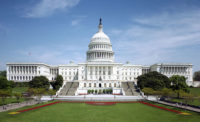On July 22, the U.S. House of Representatives Subcommittee on Energy and Power held a markup session on draft legislation that would, among other things, delay the U.S. Department of Energy’s (DOE’s) proposed 92 percent AFUE national furnace standard rulemaking and give stakeholders an opportunity to negotiate a new standard. Less than two weeks before that, the deadline for stakeholders to comment on the contentious furnace standard came and went, leaving the DOE to promulgate its final rule.
Meanwhile, as the DOE works on its final rule and Congress works on possibly delaying that rule, HVAC industry stakeholders have settled into a tenuous holding pattern with no other option than to wait and see what happens next.
FATAL FLAWS
Charlie McCrudden, senior vice president of government relations for ACCA, said many industry organizations — including ACCA; Air-Conditioning, Heating, and Refrigeration Institute (AHRI); and Heating, Air-conditioning, and Refrigeration Distributors International (HARDI) — filed comments on the proposed standard before the July 10 deadline. The problem with the proposed standard, he said, is that it’s based on data and analyses that are incorrect or incomplete.
“We found that many economic inputs the DOE assumed for installation costs were off, which corrupted the final economic analysis of the life cycle cost and payback period and painted a rosier picture for homeowners,” McCrudden explained. “They’re inflating the benefits to a 92 percent standard. We feel there is a condensing furnace penalty in some installations, and that makes it difficult for many homeowners to justify a 92 percent furnace. The fact that 31 percent of homeowners in the South will never see a payback is concerning, and the DOE’s threshold for those who don’t get a benefit is too high. No matter how much energy they save, they’ll never see a return on investment because they had to pay so much for installation costs related to venting that exceed the cost of the basic installation [for a noncondensing furnace].”
AHRI also submitted similar comments.
“We had our own study done,” said Frank Stanonik, chief technical advisor at AHRI. “We hired an outside consultant, and, based on his review and our review, we submitted comments that the analysis the DOE did does not really justify any changes [to the standard].”
THE WAITING GAME
As the industry waits on the DOE, stakeholders are also keeping an eye on the legislation that could delay the department’s rulemaking.
“There have been ongoing discussions to find an appropriate alternative to the 92 percent rule to preserve the option for noncondensing furnaces,” McCrudden said. “And, there’s the draft legislation in the House Committee on Energy and Commerce that has a provision delaying the implementation of the rule.”
That draft legislation, as it’s currently written, would require the DOE to update its proposed furnace rule by Oct. 31 to provide notice and an opportunity to comment on separating nonweatherized natural gas furnaces into two or more product classes with separate energy conservation standards based on input rate. Stakeholders would have until Jan. 1, 2016, to submit their joint recommendations, which will evaluate the negotiated standards and publish notice of the potential adoption of the standards proposed in the joint statement. The DOE will then solicit public comments for at least 30 days before publishing a final rule between July 1, 2016, and July 31, 2016.
“Whether that can work its way through and be signed before the DOE finalizes the rule, I don’t know,” said Jon Melchi, vice president of government affairs and business development, HARDI. “The one thing I can say is that all the stakeholders — the energy-efficiency community, utilities, builders, HVAC — seem to be working together on something that is palatable to everyone. That being said, there were some compelling comments that there may be flaws within DOE’s analysis, and maybe some process flaws, as well. I think those are certainly going to be thought out.”
ASKING FOR MORE TIME
Industry leaders have made it clear they support energy-efficiency standards, but only when those standards are technologically feasible for the manufacturers and economically justified for the entire supply chain, all the way down to the end user. In this case, the industry is requesting more time — either from DOE or from Congress — to find a better solution that meets those criteria.
“We’re still supportive of trying to save energy and promoting energy-efficient products, but it has to be the right choice for the consumer — it has to be economically appropriate for them. It can’t be a rule that puts some people in a bad position when they need a furnace,” Stanonik said. “Since the court remanded this whole rule to the DOE [last year], we’ve been in discussions with all of the interested stakeholders to see if there is some point where everybody could agree on a revised standard.”
Some stakeholders also agree that, unless changes are made to the proposed standard, the DOE could very well find itself the target of another lawsuit.
“If the DOE finalizes that rule at 92 percent and there is no fix, almost certainly this will be litigated,” Melchi said. “Nobody wants to be opposed to everything, and nobody wants to be in court, but as far as the 92 percent proposed rule goes, we’re just sitting there at this crossroads of what technology will allow us to do versus the real cost to consumers and viability in certain markets. There is a social cost to these regulations.”
Regardless whether an act of Congress or a decision from the DOE buys more time, stakeholders have been vocal about their willingness to come up with a solution that is fair to everyone involved.
“That’s really kind of, in a nutshell, what we’re trying to tell DOE,” Stanonik said. “Give all of us who are involved a little more time to see if we can hammer something out.”
Publication date: 8/24/2015
Want more HVAC industry news and information? Join The NEWS on Facebook, Twitter, and LinkedIn today!








